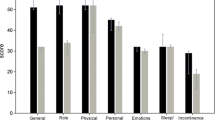Abstract
Introduction and hypothesis
Information on urethral bulking therapy in women after previous pelvic radiotherapy is lacking. This study compared the safety and efficacy of polyacrylamide intraurethral injections in patients with and without previous radiotherapy.
Methods
A total of 46 patients with severe stress urinary incontinence (SUI) were enrolled in this multicenter prospective trial. Group A consisted of 24 patients with previous radiotherapy to the pelvis for the treatment of a gynaecological malignancy. Group B consisted of 22 patients without previous radiotherapy. All patients were treated with a transurethral injection of a bulking solution (Bulkamid). The average follow-up was 12.4 months. The paired Wilcoxon test was used to compare the results before and after the procedure within the groups, and the two-sample Wilcoxon test was used for comparisons between groups.
Results
Complete continence was achieved in 25 % of patients in group A and in 36.4 % of patients in group B. Significantly reduced urine leakage was observed in both groups (p = 0.0164 in group A and p = 0.0002 in group B). The total scores in the International Consultation on Incontinence Questionnaire decreased by 5.2 in group A (p = 0.0000) and 6.36 in group B (p = 0.0001). The scores for the Total Patient Perception of Bladder Condition decreased by 1.54 in group A (p = 0.0001) and 2.59 in group B (p = 0.0000), with a significant difference between groups (p = 0.0224). No clinically significant changes in urodynamic parameters were observed. No severe adverse events were noted.
Conclusions
Based on our results, we conclude that urethral bulking therapy is a valuable treatment option in patients with severe SUI who have undergone pelvic radiotherapy for the treatment of gynaecological malignancy.
Similar content being viewed by others
References
Serati M, Salvatore S, Uccella S, Artibani W, Novara G, Cardozo L, Bolis P (2009) Surgical treatment for female stress urinary incontinence: what is the gold-standard procedure? Int Urogynecol J Pelvic Floor Dysfunct 20(6):619–621
Torrey R, Rajeshuni N, Ruel N, Muldrew S, Chan K (2013) Radiation history affects continence outcomes after advance transobturator sling placement in patients with post-prostatectomy incontinence. Urology 82(3):713–717
Christensen LH, Nielsen JB, Mouritsen L, Sorensen M, Lose G (2008) Tissue integration of polyacrylamide hydrogel: an experimental study of periurethral, perivesical, and mammary gland tissue in the pig. Dermatol Surg 34(Suppl 1):S68–S77
Avery K, Donovan J, Peters T, Shaw C, Gotoh M, Abrams P (2004) The ICIQ: a brief and robust measure for evaluating the symptoms and impact of urinary incontinence. Neurourol Urodyn 23(4):322–330
Coyne KS, Matza LS, Kopp Z et al (2006) The validation of the patient perception of bladder condition (PPBC): a single-item global measure for patients with overactive bladder. Eur Urol 49(6):1079–1086
Price DM, Noblett K (2012) Comparison of the cough stress test and 24-h pad test in the assessment of stress urinary incontinence. Int Urogynecol J 23(4):429–433
Schäfer W, Abrams P, Liao L, Mattiasson A, Pesce F, Spangberg A, Sterling AM, Zinner NR, van Kerrebroeck P; International Continence Society (2002) Good urodynamic practices: uroflowmetry, filling cystometry, and pressure-flow studies. Neurourol Urodyn 21:261–274
Gellrich J, Hakenberg OW, Oehlschläger S, Wirth MP (2003) Manifestation, latency and management of late urological complications after curative radiotherapy for cervical carcinoma. Onkologie 26(4):334–340
Kinn AC (2001) Tension-free vaginal tape evaluated using patient self-reports and urodynamic testing – a two-year follow-up. Scand J Urol Nephrol 35(6):484–490
Erekson EA, Sung VW, DiSilvestro PA, Myers DL (2009) Urinary symptoms and impact on quality of life in women after treatment for endometrial cancer. Int Urogynecol J Pelvic Floor Dysfunct 20(2):159–163. doi:10.1007/s00192-008-0755-z
Ghoniem G, Corcos J, Comiter C et al (2009) Cross-linked polydimethyl siloxane injection for female stress urinary incontinence: results of a multicenter, randomized controlled, single-blind study. J Urol 181:204–210
Herschorn S, Radomski SB (1997) Collagen injections for genuine stress urinary incontinence: patient selection and durability. Int Urogynecol J 8:18–24
Sokol ER, Karram MM, Dmochowski R (2014) Efficacy and safety of polyacrylamide hydrogel for the treatment of female stress incontinence: a randomized, prospective, multicenter North American study. J Urol 192:843–849
Vecchioli-Scaldazza CV, Smaali C, Morosetti C, Azizi B, Giannubilo W, Ferrara V (2014) Polyacrylamide hydrogel (Bulkamid®) in female patients of 80 or more years with urinary incontinence. Int Braz J Urol 40(1):37–43. doi:10.1590/S1677-5538.IBJU.2014.01.06
Cespedes RD, Serkin FB (2009) Is injection therapy for stress urinary incontinence dead? No. Urology 73(1):11–13
Trutnovsky G, Tamussino K, Greimel E, Bjelic-Radisic V (2011) Quality of life after periurethral injection with polyacrylamide hydrogel for stress urinary incontinence. Int Urogynecol J 22(3):353–356. doi:10.1007/s00192-010-1296-9
Mohr S, Siegenthaler M, Mueller MD, Kuhn A (2013) Bulking agents: an analysis of 500 cases and review of the literature. Int Urogynecol J 24(2):241–247. doi:10.1007/s00192-012-1834-8
Martan A, Masata J, Svabík K, Krhut J (2014) Transurethral injection of polyacrylamide hydrogel (Bulkamid®) for the treatment of female stress or mixed urinary incontinence. Eur J Obstet Gynecol Reprod Biol 178:199–202
Acknowledgments
Authors thank Josef Tvrdik for the statistical analysis. This study was supported by the Grant Agency of the Ministry of Health, Czech Republic, NT/13509-4.
Conflicts of interest
J. Krhut: none
A. Martan: preceptor for Bard, Meditrade; consultant for Astellas
M. Jurakova: none
D. Nemec: none
J. Masata: none
P. Zvara: none
Author information
Authors and Affiliations
Corresponding author
Rights and permissions
About this article
Cite this article
Krhut, J., Martan, A., Jurakova, M. et al. Treatment of stress urinary incontinence using polyacrylamide hydrogel in women after radiotherapy: 1-year follow-up. Int Urogynecol J 27, 301–305 (2016). https://doi.org/10.1007/s00192-015-2834-2
Received:
Accepted:
Published:
Issue Date:
DOI: https://doi.org/10.1007/s00192-015-2834-2




